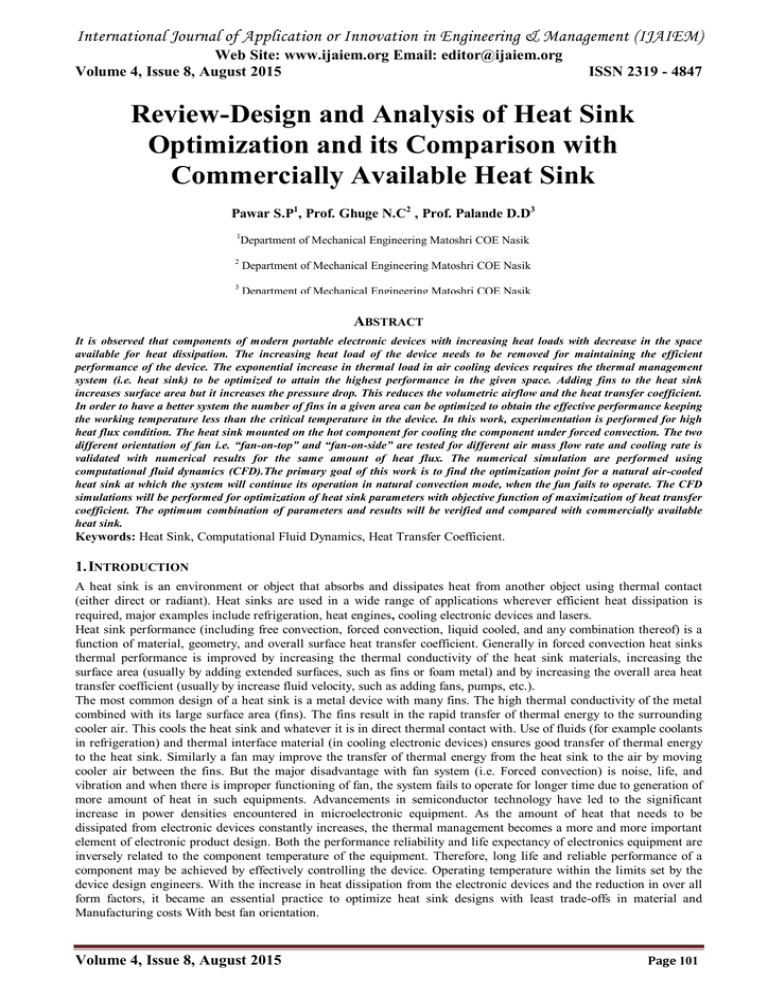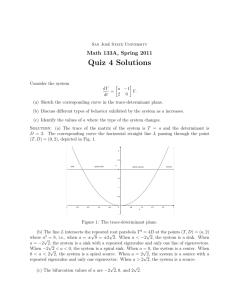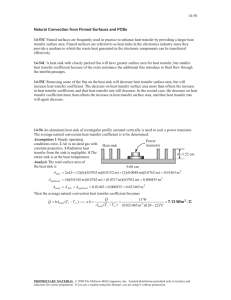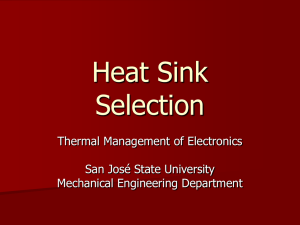International Journal of Application or Innovation in Engineering & Management... Web Site: www.ijaiem.org Email: Volume 4, Issue 8, August 2015
advertisement

International Journal of Application or Innovation in Engineering & Management (IJAIEM) Web Site: www.ijaiem.org Email: editor@ijaiem.org Volume 4, Issue 8, August 2015 ISSN 2319 - 4847 Review-Design and Analysis of Heat Sink Optimization and its Comparison with Commercially Available Heat Sink Pawar S.P1, Prof. Ghuge N.C2 , Prof. Palande D.D3 1 Department of Mechanical Engineering Matoshri COE Nasik 2 Department of Mechanical Engineering Matoshri COE Nasik 3 Department of Mechanical Engineering Matoshri COE Nasik ABSTRACT It is observed that components of modern portable electronic devices with increasing heat loads with decrease in the space available for heat dissipation. The increasing heat load of the device needs to be removed for maintaining the efficient performance of the device. The exponential increase in thermal load in air cooling devices requires the thermal management system (i.e. heat sink) to be optimized to attain the highest performance in the given space. Adding fins to the heat sink increases surface area but it increases the pressure drop. This reduces the volumetric airflow and the heat transfer coefficient. In order to have a better system the number of fins in a given area can be optimized to obtain the effective performance keeping the working temperature less than the critical temperature in the device. In this work, experimentation is performed for high heat flux condition. The heat sink mounted on the hot component for cooling the component under forced convection. The two different orientation of fan i.e. “fan-on-top” and “fan-on-side” are tested for different air mass flow rate and cooling rate is validated with numerical results for the same amount of heat flux. The numerical simulation are performed using computational fluid dynamics (CFD).The primary goal of this work is to find the optimization point for a natural air-cooled heat sink at which the system will continue its operation in natural convection mode, when the fan fails to operate. The CFD simulations will be performed for optimization of heat sink parameters with objective function of maximization of heat transfer coefficient. The optimum combination of parameters and results will be verified and compared with commercially available heat sink. Keywords: Heat Sink, Computational Fluid Dynamics, Heat Transfer Coefficient. 1. INTRODUCTION A heat sink is an environment or object that absorbs and dissipates heat from another object using thermal contact (either direct or radiant). Heat sinks are used in a wide range of applications wherever efficient heat dissipation is required, major examples include refrigeration, heat engines, cooling electronic devices and lasers. Heat sink performance (including free convection, forced convection, liquid cooled, and any combination thereof) is a function of material, geometry, and overall surface heat transfer coefficient. Generally in forced convection heat sinks thermal performance is improved by increasing the thermal conductivity of the heat sink materials, increasing the surface area (usually by adding extended surfaces, such as fins or foam metal) and by increasing the overall area heat transfer coefficient (usually by increase fluid velocity, such as adding fans, pumps, etc.). The most common design of a heat sink is a metal device with many fins. The high thermal conductivity of the metal combined with its large surface area (fins). The fins result in the rapid transfer of thermal energy to the surrounding cooler air. This cools the heat sink and whatever it is in direct thermal contact with. Use of fluids (for example coolants in refrigeration) and thermal interface material (in cooling electronic devices) ensures good transfer of thermal energy to the heat sink. Similarly a fan may improve the transfer of thermal energy from the heat sink to the air by moving cooler air between the fins. But the major disadvantage with fan system (i.e. Forced convection) is noise, life, and vibration and when there is improper functioning of fan, the system fails to operate for longer time due to generation of more amount of heat in such equipments. Advancements in semiconductor technology have led to the significant increase in power densities encountered in microelectronic equipment. As the amount of heat that needs to be dissipated from electronic devices constantly increases, the thermal management becomes a more and more important element of electronic product design. Both the performance reliability and life expectancy of electronics equipment are inversely related to the component temperature of the equipment. Therefore, long life and reliable performance of a component may be achieved by effectively controlling the device. Operating temperature within the limits set by the device design engineers. With the increase in heat dissipation from the electronic devices and the reduction in over all form factors, it became an essential practice to optimize heat sink designs with least trade-offs in material and Manufacturing costs With best fan orientation. Volume 4, Issue 8, August 2015 Page 101 International Journal of Application or Innovation in Engineering & Management (IJAIEM) Web Site: www.ijaiem.org Email: editor@ijaiem.org Volume 4, Issue 8, August 2015 ISSN 2319 - 4847 2. LITERRATURE REVIEW S.C.Fok et.al. conducted an experimental study on the cooling of portable hand-held electronic devices using neicosane as the phase change material (PCM) placed inside heat sinks with and without internal fins. The effects of the PCM, number of fins, orientation of the device, and the power level (ranging from 3 to 5 W), on the transient thermal performances were investigated under frequent, heavy and light usage conditions. The results indicated that PCM-based heat sinks with internal fins are viable options for cooling mobile devices but the effectiveness of the approach may require optimization with respect to the amount of PCM used, the number of fins, the power level of the heat source, and the usage mode of the device. Sidy Ndao et.al. proposed a multi-objective thermal design optimization and comparative study of electronics cooling technology. The cooling technologies considered are continuous parallel micro-channel heat sinks, inline and staggered circular pin-fin heat sinks, offset strip fin heat sinks, and single and multiple submerged impinging jet. Using water and HFE-7000 as coolants, Matlab’s multi-objective genetic algorithm functions were utilized to determine the optimal thermal design of each technology based on the total thermal resistance and pumping power consumption under constant pressure drop and heat source base area of 100 mm2. Plots of the Pareto front indicate a trade-off between the total thermal resistance and pumping power consumption. In general, the offset strip fin heat sink outperforms the other cooling technologies. Dong-kwon kim et.al. proposed thermal optimization of a plate-fin heat sink with the fin thickness varying in the direction normal to the fluid flow was conducted. The model used for this optimization was based on the volume averaging theory. It was shown that the thermal resistance of the plate-fin heat sink can be reduced by allowing the fin thickness to increase in the direction normal to the fluid flow. In the case of a water-cooled heat sink, the thermal resistance decreases by as much as 15%. The amount of the reduction increases as the pumping power increases or as the length of the heat sink decreases. Loannis K.Karathanassis et.al. proposed An optimization methodology for a micro channel, plate-fin heat sink suitable for the cooling of a linear parabolic trough Concentrating Photovoltaic/Thermal system is applied in this study. Two different micro channel configurations are considered, Fixed and stepwise Variable-Width micro channels respectively. The performance evaluation criteria comprise the thermal resistance of the heat sink and the cooling medium pressure drop through the heat sink. The overall analysis demonstrated that micro channel heat sinks are ideal for high heat flux dissipation as they achieve thermal resistance values as low as 0.0082 K/W. The optimization procedure results in the optimal trade off between the two evaluation criteria e thermal resistance and cooling fluid pressure drop, which are of mutually conflicting nature. Additionally, the introduction of stepwise variable-width micro channels significantly improves. Chyi-Tsong Chen and Hung I Chen proposed Heat-sink with air-cooling fan is the simplest and the most effective way to disperse generated heat of a high-tech device. A common approach to optimize heat sinks is based on the minimization of the entropy generation rate that takes the two major heat dissipation factors, heat transfer rate and air resistance, into consideration. However, a lower entropy generation rate often corresponds to a larger size of the designed heat sink. To have a balance design of heat sinks for heat dissipation, this paper considers simultaneously minimization of the entropy generation rate and the material cost of the heat sinks. A multi-objective real-coded genetic algorithm using a novel direction-based crossover operator is developed for the formulated optimal heat sink design problem. With the proposed design framework, he compared and evaluate the performance of the plate-fins equipped with flow-through and impingement-flow air cooling systems. Extensive simulation results show that the balance design for heat sinks can achieve both the benefits of light weight and excellent heat dissipation. Koga Adriano A. et.al. Small scale fluid flow systems have been studied for various applications, such as chemical reagent dosages and cooling devices of compact electronic components. This work proposes to present the complete cycle development of an optimized heat sink designed by using Topology Optimization Method (TOM) for best performance, including minimization of pressure drop in fluid flow and maximization of heat dissipation effects, aiming small scale applications. Kumar Mukesh et.al. Proposed The continual development of faster desktop computers being sold at lower prices into the market place has demanded that thermal management engineers develop and optimize thermal management devices that not only perform better, but are at the same or lower cost than previous generations. The ever shrinking form factor has also increased the burden placed on today's thermal management devices. Matthew B. De Stadler gives the results of the study to develop a geometry based optimization tool for heat sink design. The results obtained from this study are applied to development of an optimal heat sink for use in skin cooling of hypersonic vehicle. Paulo Canhoto et.al. addressed optimization of heat sink formed by parallel circular or non circular ducts in a finite volume and obtained results for optimum thermal length, optimum hydraulic diameter and maximum heat transfer rate. Lin Lin et.al. proposed three dimensional solid fluid conjugated model which is coupled with a simplified conjugate gradient to optimize the flow and a heat transfer in water cooled, silicon based double layer microchannel heat sink. Kyoungwoo Park et.al .performed numerical study on shape optimization of the plate fin type heat sink with an air deflector to minimise the pressure loss subjected to the desired maximum temperature and geometrical constraints. In Volume 4, Issue 8, August 2015 Page 102 International Journal of Application or Innovation in Engineering & Management (IJAIEM) Web Site: www.ijaiem.org Email: editor@ijaiem.org Volume 4, Issue 8, August 2015 ISSN 2319 - 4847 this study Kringing method which is one of the metamodels associated with the CFD is used to obtain optimal solution. R.Mohan and Dr. Govindrajan describes about pin fin and slot parallel plate heat sinks with copper and carbon carbon composites (CCC) base plate mounted on CPU. In this paper study of complete computer chassis with different heat sinks is done and the performances of heat sinks are compared. 3. CONCLUDING REMARKS FROM LITERATURE REVIEW From the study of above research papers following concluding remarks are drawn related to heat transfer enhancement and heat sink optimization with space as a main constrain. Heat Transfer enhancement in Thermal management System of electronic cooling applications can be achieved by using different cooling Techniques like use of Internal micro channel fins, Varying fin thickness, Phase change materials, variety of heat sink profiles by using air cooling fan, using different cellular materials etc. Plate fins manufacturing is comparatively Simple than other types of fins for heat sink. Cost reduction and increase in overall shrinking form factor. 4. PROBLEM DEFINATION In commercial thermal management system using plate fin heat sinks, fan may improve the transfer of thermal energy from the heat sink to air by moving cooler air between the fins but the various disadvantages observed in such a system is as follows. Disadvantages- i) Noise ii)Vibration iii) When there is improper functioning of fan the system fails to operate for longer time due to generation of more amount of heat in such equipments. iv) The better orientation of fan in forced convection system is needs to be determined, with space as main constrain for such a compact systems. 5. OBJECTIVE OF THE PROJECT 1. To design a Heat Sink for given heat load for electronic cooling application to maintain the part temperature below critical limit with space Constrain (cooling area) in fan failed condition. Parameters to be designed: 1) No. of fins 2) Pitch of fins 2) Length of fins 4) Fin profile 2) To Check efficient orientation of fan for better cooling i.e. Fan on top (FOT) and fan on side (FOS) for cooling the heat sink. 3) To optimize the commercialize heat sink for better cooling in natural convection condition. (i.e. fan failed condition) The CFD simulations will be performed for optimization of heat sink parameters with objective function of maximization of heat transfer coefficient and the Performance comparison (Temperatures, Pressure drop and heat transfer rates) of optimized heat sink results with commercially available heat sink is to be done. 6. ACKNOWLEDGEMENT I express deep sense of gratitude towards my guide Prof. N.C.Ghuge for his encouragement, support, and supervision. I am thankful to Prof. D.D.Palande for his encouragement and moral support for completion of this paper. I heartily express my gratefulness to Prof. J.H.Bhangale who has been a constant source of inspiration. 7.CONCLUSION In this experiment the primary goal is to study the performance of heat sink with different orientation of the fan. The experimental and numerical study will be performed. The main objective of this study is to find better configuration of a heat sink which can work smoothly even after the temperature inside the component exceeds the IGBT permissible temperature. Best optimized configuration of given heat sink will be found. This will be achieved with the help of experimental & numerical study Volume 4, Issue 8, August 2015 Page 103 International Journal of Application or Innovation in Engineering & Management (IJAIEM) Web Site: www.ijaiem.org Email: editor@ijaiem.org Volume 4, Issue 8, August 2015 ISSN 2319 - 4847 REFERANCE [1] S.C.Fok, W. Shen, F.L.Tan., Cooling of portable hand held electronic devices using phase change materials in finned heat sinks, International journal of thermal sciences 49(2010) 109-117,Elsevier, 2009. [2] Ndao S., Peles Y., Jenson M.K., Multi-objective thermal design optimization and comparative analysis of electronics cooling technologies, International Journal of Hear and Mass Transfer 52 (2009) 4317-4326, Elseveir, 2009. [3] Kim D., Jung J., Kim S.,Thermal optimization of plate-fin heat sinks with variable fin thickness, International Journal of Hear and Mass Transfer 53(2010) 5988-5995,Elseveir,2010. [4] Canhoto P., Reis A., Optimization of forced convection heat sinks with pumping power requirements , International Journal of Hear and Mass Transfer 54 (2011) 1441-1447,Eleseveir 2010. [5] Karathanassis L.,Papanicolaou E.,Belessiotis V.,Bergeles G.,Multi-objective optimization of a micro heat sink for concentrating photovoltaic/Thermal system using a genetic algorithm, Applied Thermal Engineering 59(2013) 733-744,Elsevier,2012 [6] Tsong C.,and Chen H.,Multi-objective optimization design of plate fin heat sink using a direction based genetic algorithm,Journal of the Taiwan Institute of chemical Engineers 44(2013) 257-265 Elesevier 2013 [7] Kumar M., Kumar A., Kumar S., Optimum design and selection of heat sink (IJAIEM) ISSN 2319-4847 [8] Matthew B. de Stadler., Optimization of the geometry of a heat sink, university of Virginia, Charlottesville, VA22904 [9] Canhoto P., Reis A., Optimization of forced convection heat sinks with pumping power requirements , International Journal of Hear and Mass Transfer 54 (2011) 1441-1447,Eleseveir 2010. [10] Koga A., C Edson., Nova H., Lima C., Silva E., Development of heat sink by using topology optimization , International Journal of Hear and Mass Transfer 64 (2013) 759-722 [11] Kyoungwoo Park., Park-Kyoun oh., Hyo-Jae Lim., The application of the CFD and Kringing method to an optimization of heat sink, International Journal of Heat and Mass Transfer 49 (2006) 3439-3447 ,Elsevier 2006. [12] R.Mohan and Dr.P.Govindrajan., Thermal analysis of CPU with Composite pin fin heat sinks, International journal of engineering science and technology vol2(9),2010,4051-4062 [13] Incropera / Dewitt / Bergman / Lavine / “Fundamentals of heat and mass transfer” 6th edition willi publication. Volume 4, Issue 8, August 2015 Page 104





